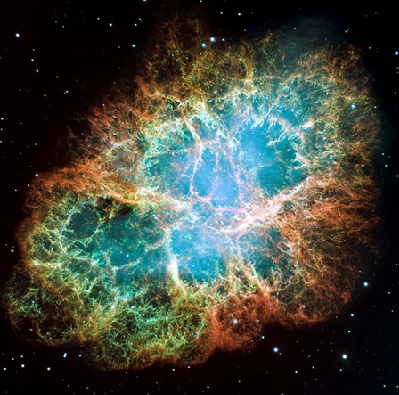31 August 2014

This Hubble Space Telescope picture shows the remains of a dead massive star, a huge glowing cloud that resulted from the explosion of the star.
Credit: NASA, ESA, J. Hester and A. Loll (Arizona State University)
Astronomers using data from the Integral space observatory of the European Space Agency (ESA), have revealed that a white dwarf, a small, extremely dense stellar object, which is created during the death of a Sun-like star, can reignite and explode as a supernova. Supernovas are tremendous explosions of stars. They are among the most spectacular and most violent cosmic phenomena.
As Integral explores the universe in gamma rays, the characteristic gamma-ray signature of the radioactive elements produced in one type of supernovas, termed type Ia supernova, was detected for the first time. Type Ia supernovas have been speculated to be the result of the explosion of a white dwarf pulling and accreting material from a nearby companion star.
However, definitive evidence for the involvement of a white dwarf in these catastrophic events was lacking. This evidence was for radioactive nuclei being produced by nuclear fusion reactions, during the explosion of the white dwarf. Integral is capable of detecting the gamma radiation from this fusion, but astronomers had to find a type Ia supernova in a nearby galaxy. Although type Ia supernovas occur frequently across the universe, a type Ia supernova typically occurs in a single galaxy at intervals of a few hundred years.
The opportunity came in January 2014, when students at the University College London’s teaching observatory at Mill Hill, UK, discovered a type Ia supernova, later termed SN2014J, in the nearby galaxy M82.
According to theory, the carbon and oxygen present in a white dwarf should be fused into radioactive nickel during the explosion. This radioactive nickel should then quickly decay into radioactive cobalt, which would then decay into stable iron.
Due to the proximity (by cosmic standards) of the host galaxy, M82, lying about 11.5 million light-years away from Earth, SN2014J is the closest of its type to be detected in decades. Using Integral to study the aftermath of the mighty explosion, scientists searched for the signature of cobalt decay, and found it, in exactly the quantities predicted theoretically.
References
ESA Website
Wikipedia
Aymen Mohamed Ibrahem
Senior Astronomy Specialist